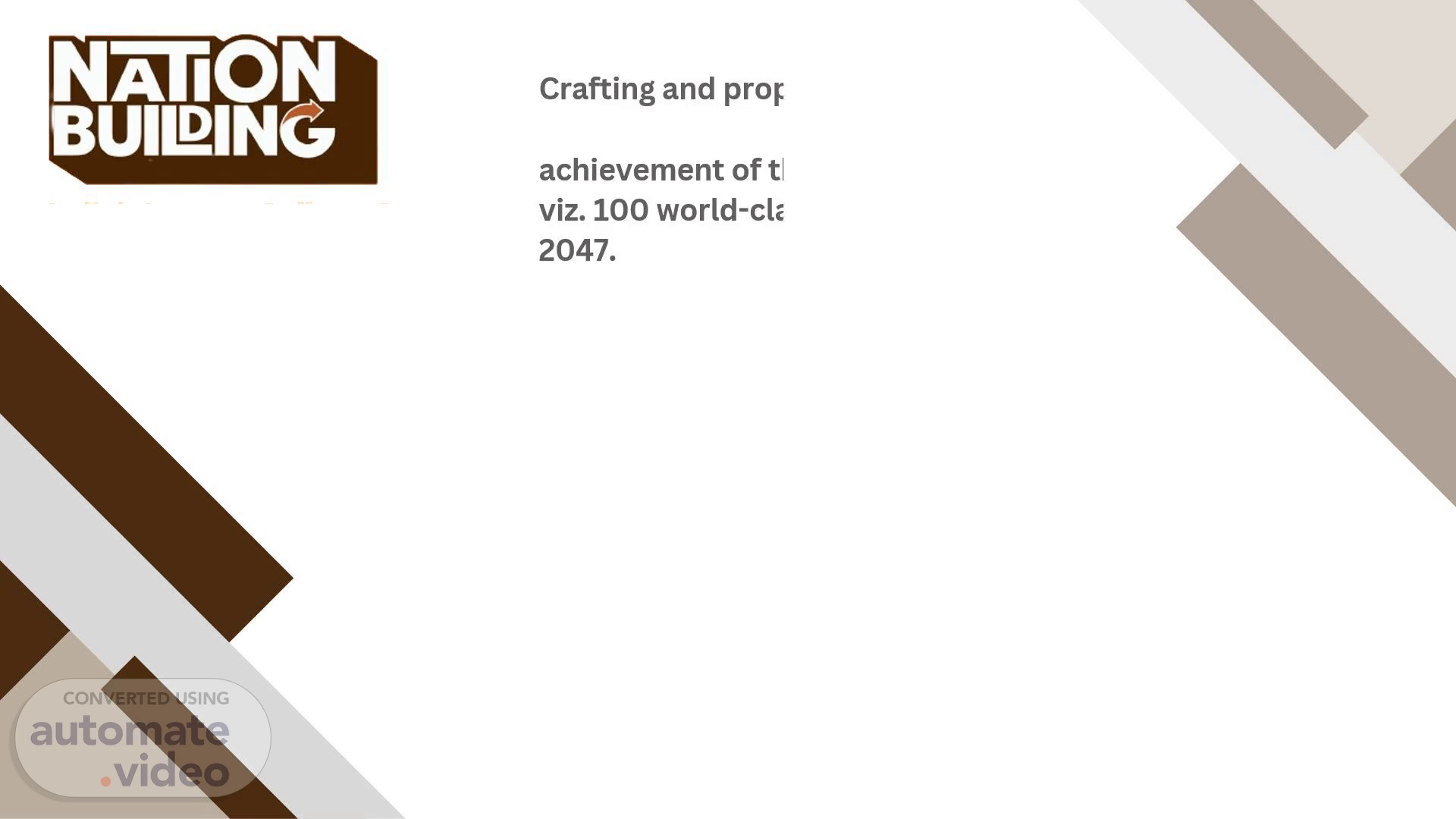
UBY8747G_CentralZone
Scene 1 (0s)
Zone :. Central zone. Team ID :. UBY8747G. Tushar porwal.
Scene 2 (28s)
Bridge the access-quality gap in higher education: Achieve 100 world-class institutions and 75% tertiary GER by 2047 under “ Viksit Bharat”..
Scene 3 (1m 49s)
POLITICAL SOCIAL AND LEGAL ECONOMIC TECHNOLOGICAL Government Policy Priorities guiding the establishment and advancement Inter-State Cooperation : Collaborative efforts among states and central government entities ensure equitable distribution of educational resources. Stakeholder Engagement Effective political leadership and stakeholder engagement mobilize resources and garner support Institutional Autonomy and Regulations P E S T Funding Availability and Accessibility Government budget allocations and accessibility to funding channels impacts development Affordability of Education : Mitigating financial barriers is pivotal and directly influences enrollment rates. Labor Market Demands: Aligning educational programs with market needs strengthening institutional competitiveness. Industry Partnerships and Research Social Perception of Education: Societal attitudes towards education significantly impact demand. Access to Education :Social disparities, including income inequality, pose significant barriers to educational access. Legal Framework for Institutional Establishment: Clear and conducive legislative frameworks governing institutional establishment Equity and Inclusion Laws Digital Accessibility Initiatives: Narrowing educational disparities ,promoting inclusivity and contributing to GER enhancement. ICT Infrastructure Development: Enhanced access to technology bolsters GER by reaching previously underserved populations. Mobile Learning Solutions: augments educational accessibility, particularly in remote areas. Data Analytics for Equity Monitoring PEST Analysis.
Scene 4 (3m 16s)
Collaborations. Education policie’s and Regulatory framework.
Scene 5 (4m 27s)
Private institutions have stronger ties with industries, providing students with practical exposure, internships, and employment opportunities. Industry Collaboration Many top-ranking universities in the USA are private, contributing to a strong global reputation and attracting international students. Global Rankings and Recognition Private Higher Education in the USA Current Education Model in India Majority of top institutions are private and autonomous, allowing for quicker decision-making and flexibility. Ownership and Governance Private institutions rely on diverse funding sources, including donations, endowments, and tuition fees, fostering financial independence. Funding and Resources Private institutions often have the flexibility to adapt curriculum, adopt new technologies, and respond swiftly to industry needs. Innovation and Flexibility Public institutions may have limited industry collaborations, impacting students' exposure to real-world applications of their education. Industry Collaboration Indian universities, while improving, may face challenges in global recognition due to varied quality standards and resource limitations. Global Rankings and Recognition Many institutions are government-owned, leading to bureaucratic processes and slower decision-making. Ownership and Governance Many Indian universities face budget constraints and dependence on government funding, impacting resource availability. Funding and Resources Public universities may face more bureaucratic hurdles in implementing changes, slowing down innovation and adaptation. Innovation and Flexibility USA's Private Prowess vs India's Public Paradigm.
Scene 6 (6m 30s)
Segmentation. Urban Centers with Emerging Educational Hubs: Some cities may have a growing presence of educational institutions and a potential to become educational hubs. These urban centers can strategize to attract investment and partnerships to develop their educational infrastructure and elevate the quality of their institutions..
Scene 7 (7m 54s)
Inculcate quality control measures in research output, tracking relevant metrics such as citation rate, h-index, etc. Promote and fund research-focused HEIs to increase spend on R&D (as a proportion of GDP) to reach 1.5-2% invest; Facilitate identification of local ‘problem statements’ through local administrative bodies.
Scene 8 (9m 0s)
Targeted Audience. Marketing. Partnerships. Community Involvement.
Scene 9 (9m 24s)
3. Public-Private Collaboration Years 2030-2032: Foster HEI-industry-government partnerships for research, faculty exchanges, skill programs. Years 2032-2034: Create innovation hubs for academia, startups, corporations to collaborate on research. Progress Prediction: By 2034, we envision 50 world-class HEIs actively engaged in collaborative initiatives. 4. Digitalization and Lifelong Learning Years 2034-2036:Invest in digital infrastructure, online platforms, virtual labs for lifelong learning. Progress Prediction: By 2036, digitalization efforts should lead to a 25% increase in GER through flexible learning options..
Scene 10 (11m 4s)
Impact Quantification. E V A L U A T I O N. Note: Universities employ various strategies to fund their operations and provide quality education. Here are the key sources of revenue: Tuition and Fees, Government Funding, Research Grants and Contracts, Fundraising and Alumni Contributions , etc..
Scene 11 (12m 14s)
References. https://aishe.gov.in/aishe/home pib.gov.in/PressReleaseIframePage.aspx?PRID=189451 https://www.education.gov.in/statistics-new https://www.topuniversities.com/world-university-rankings?tab=indicators https://pib.gov.in/PressReleseDetailm.aspx?PRID=1894517 https://studyinindia.gov.in/about-indian-higher-education-#:~:text=Indian%20Higher%20Education%20System&text=The%20entire%20higher%20education%20ecosystem,of%20the%20Ministry%20of%20Education. https://educationforallinindia.com/ger-at-higher-education-level-in-india-2023/ https://www.ibef.org/blogs/rural-education-integral-to-india-s-progress https://social.niti.gov.in/education-index https://www.ibef.org/industry/education-sector-india https://facts.mit.edu/operating-financials/ https://www.investopedia.com/terms/m/marketsegmentation.asp https://www.google.com/search?q=ey+2047+report+education&sca_esv=7fb4d62672696752&rlz=1C1RXQR_en-GBIN1080IN1080&sxsrf=ACQVn08LbYLefwl5Au6c_fsTotIC_k0YvA%3A1709850772157&ei=lEDqZa2aCZLG4-EP9KKS0A4&ved=0ahUKEwittJK_muOEAxUS4zgGHXSRBOoQ4dUDCBE&uact=5&oq=ey+2047+report+education&gs_lp=Egxnd3Mtd2l6LXNlcnAiGGV5IDIwNDcgcmVwb3J0IGVkdWNhdGlvbjIFECEYoAEyBRAhGKABMgUQIRigATIFECEYoAFI3ixQqQpYkypwAXgBkAEAmAHfAaAByw6qAQUwLjkuMbgBA8gBAPgBAZgCC6AC9Q7CAgoQABhHGNYEGLADwgIHECEYChigAcICBRAhGJ8FmAMAiAYBkAYIkgcFMS45LjGgB4Eu&sclient=gws-wiz-serp.